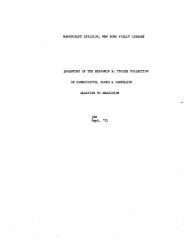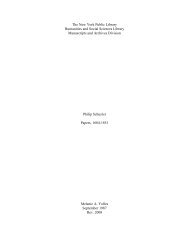pdf available - Multiple Choices
pdf available - Multiple Choices
pdf available - Multiple Choices
You also want an ePaper? Increase the reach of your titles
YUMPU automatically turns print PDFs into web optimized ePapers that Google loves.
54 LUBOML<br />
one melamed of delicate nature and good heart,<br />
who, rather than beat a student who did not do<br />
well, banged himself several times on the head.<br />
Many parents also sent their daughters for a<br />
few hours of studyseparate from the boys, of<br />
courselearning how to read prayers and a little<br />
bit of Chumash.<br />
Cheders were generally in a rebbe's private<br />
homeusually a small narrow room where the<br />
students barely fit in and were always crowded.<br />
Until the age of five or six the youngsters still<br />
enjoyed a bit of freedom of movement and a few<br />
games: pitching buttons at a hole, hide-and-seek,<br />
horses, chasing pigs and throwing stones at their<br />
non-kosher hides, and others.<br />
When the rainy autumn and snowy winter<br />
came, however, we were stuck in the narrow<br />
house of the rebbe for many long hours, except<br />
for short breaks in the afternoon to eat, and<br />
toward evening to go to the synagogue for the<br />
afternoon and evening prayers. On those days<br />
the cheder became a kind of prison, and our only<br />
wish was to escape from its yoke and its oppressive<br />
atmosphere.<br />
It is no wonder that we could hardly wait for<br />
the approach of the month of Nisanwhen we<br />
had a long breaka week before the Pesach<br />
[Passover] holiday. We were always praying for<br />
the intervention of blind fate so that something<br />
out of the ordinary would happen that would give<br />
us a bit of free time. If the rebbe got sick or<br />
someone in his family died, and as a result we<br />
were free for a day or two from studies and being<br />
cooped up in the cheder, there were no bounds to<br />
our happiness. We were always grateful to the<br />
non-Jewish government inspector of schools, who<br />
caused trembling among the melamdim who were<br />
teaching without a license, and that is how we<br />
unwittingly enjoyed a brief respite.<br />
Talmud Torah<br />
The Talmud Torah was the official educational<br />
institution of the community, and it is where<br />
primarily poor children and orphans learned,<br />
since they had no way of paying for a rebbe.<br />
The building of the Talmud Torah was largethree<br />
large classrooms and a teachers' room. In<br />
the largest front room, enlightened folks prayed<br />
on Sabbaths. There was a large field around the<br />
building where students played at recess and<br />
enjoyed a bit of fresh air.<br />
In addition to religious subjects, prayers, and<br />
Chumash, they were taught some arithmetic and<br />
Russian. The Talmud Torah was overseen by the<br />
official government-appointed rabbi, who saw to<br />
it that the education provided was in the spirit of<br />
the times.<br />
The name of the rabbi in my day was<br />
Bogoslavsky, an elderly Jew with a trimmed<br />
beard, a large, broad nose, and a square-shaped<br />
yarmulke on his head, who had a serious and strict<br />
look to his face. The permanent teacher for the<br />
students in the lower grades was Moyshe Yitshak<br />
Kagan, of blessed memory, who lived in a small<br />
house next to the Talmud Torah, in the middle of<br />
a fenced-off fruit orchard and lovely garden into<br />
which we longed to enter.<br />
The standing of the Talmud Torah and its<br />
importance grew in time, with the arrival of the<br />
licensed teacher Shammai Frankfurt from Kovel,<br />
who was well-loved by all and was, it seems, a<br />
Zionist supporter. He was elegantly dressed, had<br />
nice manners, a felt top hat on his head and a shiny<br />
walking stick in his hand, and he bowed to all in<br />
greeting. (It is worth mentioning that Shammai<br />
Frankfurt was the founder and director of the<br />
Hebrew high school in Kovel [near Luboml] in<br />
the 1920s.) Even today I can hear the lovely<br />
melodies of the songs "Zion Tamati, Zion<br />
Hemdati" and of "Sham Bamakom Arazim<br />
Menashkim Avei Rom" and others, which came<br />
through the windows of the Talmud Torah and<br />
could be heard from afar. We students in the<br />
nearby cheder would sneak up and stand under<br />
the windows and listen to those lovely songs,<br />
which touched us deeply and moved us to longing<br />
for our land.<br />
At about the age of Bar Mitzvah, many students<br />
left the cheder or Talmud Torah and slowly<br />
were initiated into the adult world, either to<br />
learn a trade or to help their parents in business.<br />
A small number did continue to studyGemara<br />
and Tosefot and even the Posekimwith the few<br />
truly learned teachers or on their own in the shtibl,<br />
helped by those who devoted all their time to<br />
Torah study for its own sake.







